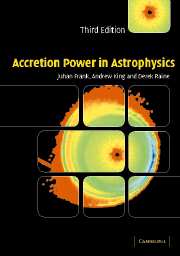Book contents
- Frontmatter
- Contents
- Preface to the first edition
- Preface to the second edition
- Preface to the third edition
- 1 ACCRETION AS A SOURCE OF ENERGY
- 2 GAS DYNAMICS
- 3 PLASMA CONCEPTS
- 4 ACCRETION IN BINARY SYSTEMS
- 5 ACCRETION DISCS
- 6 ACCRETION ON TO A COMPACT OBJECT
- 7 ACTIVE GALACTIC NUCLEI
- 8 ACCRETION DISCS IN ACTIVE GALACTIC NUCLEI
- 9 ACCRETION POWER IN ACTIVE GALACTIC NUCLEI
- 10 THICK DISCS
- 11 ACCRETION FLOWS
- Appendix: Radiation processes
- Problems
- Bibliography
- Index
Preface to the third edition
Published online by Cambridge University Press: 05 June 2012
- Frontmatter
- Contents
- Preface to the first edition
- Preface to the second edition
- Preface to the third edition
- 1 ACCRETION AS A SOURCE OF ENERGY
- 2 GAS DYNAMICS
- 3 PLASMA CONCEPTS
- 4 ACCRETION IN BINARY SYSTEMS
- 5 ACCRETION DISCS
- 6 ACCRETION ON TO A COMPACT OBJECT
- 7 ACTIVE GALACTIC NUCLEI
- 8 ACCRETION DISCS IN ACTIVE GALACTIC NUCLEI
- 9 ACCRETION POWER IN ACTIVE GALACTIC NUCLEI
- 10 THICK DISCS
- 11 ACCRETION FLOWS
- Appendix: Radiation processes
- Problems
- Bibliography
- Index
Summary
In the decade since the second edition of this book, accretion has become a still more central theme of modern astrophysics. We now know for example that a γ-ray burst briefly emits a gravitationally powered luminosity rivalling the output of the rest of the Universe. This and other startling discoveries are a result of observational progress, driven as ever by technological advances. But these advances are also having a powerful effect on theory; modern supercomputers allow one to perform as a matter of routine calculations which were unthinkable a decade ago. This increasing capability will significantly alter the way theory is done, and indeed thought about.
The impact on accretion theory has already been profound. Most obviously, supercomputer simulations have been central in verifying that angular momentum transport in accretion discs is probably mediated by the magnetorotational instability. This opens the prospect of at last understanding how accretion is driven in the discs we see.
These changes and others make a new edition of this book timely. We are grateful for the opportunity of revising and extending the treatments of the earlier editions. As always, we have been obliged to be selective, but have tried to convey the essence of recent developments. In addition to discussing the new work on disc viscosity referred to above, we give a more thorough treatment of the thermal–viscous disc instability model now generally thought to be the basic cause of the outbursts of dwarf novae and soft X-ray transients.
- Type
- Chapter
- Information
- Accretion Power in Astrophysics , pp. xiii - xivPublisher: Cambridge University PressPrint publication year: 2002



